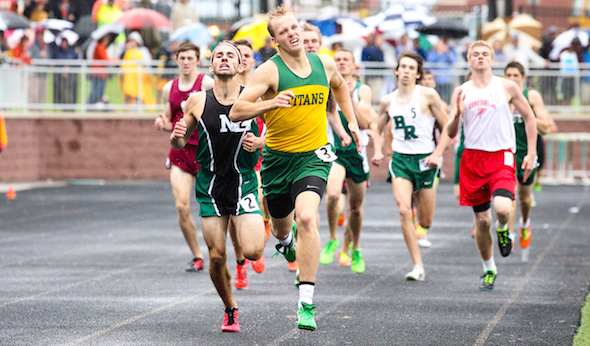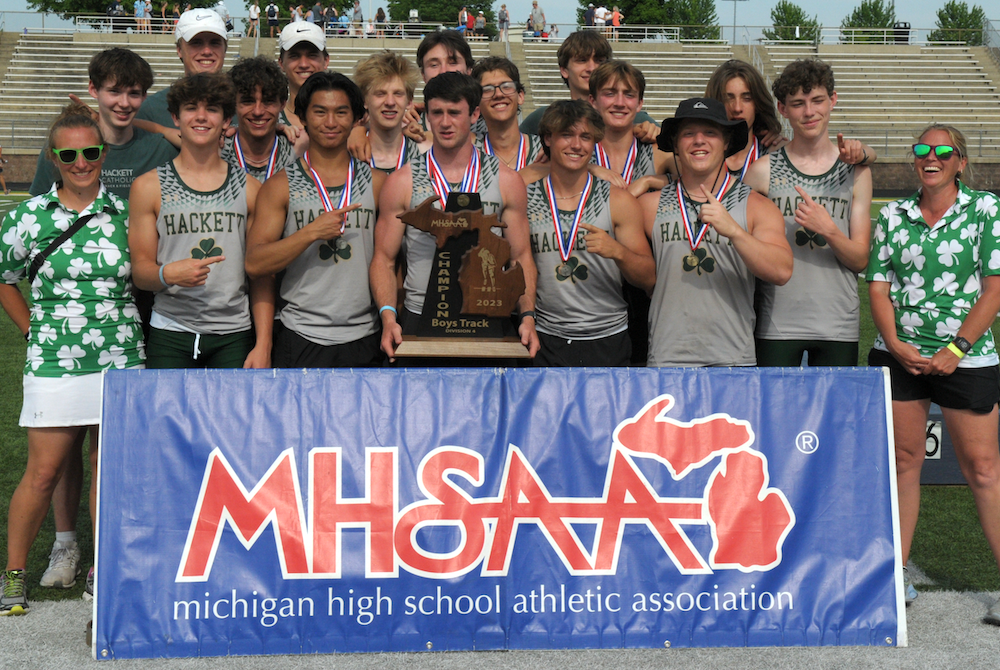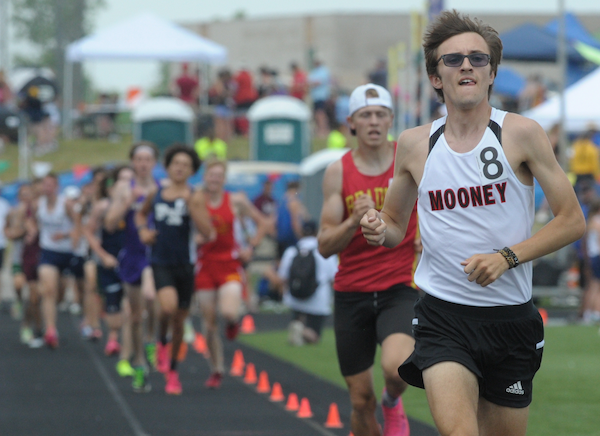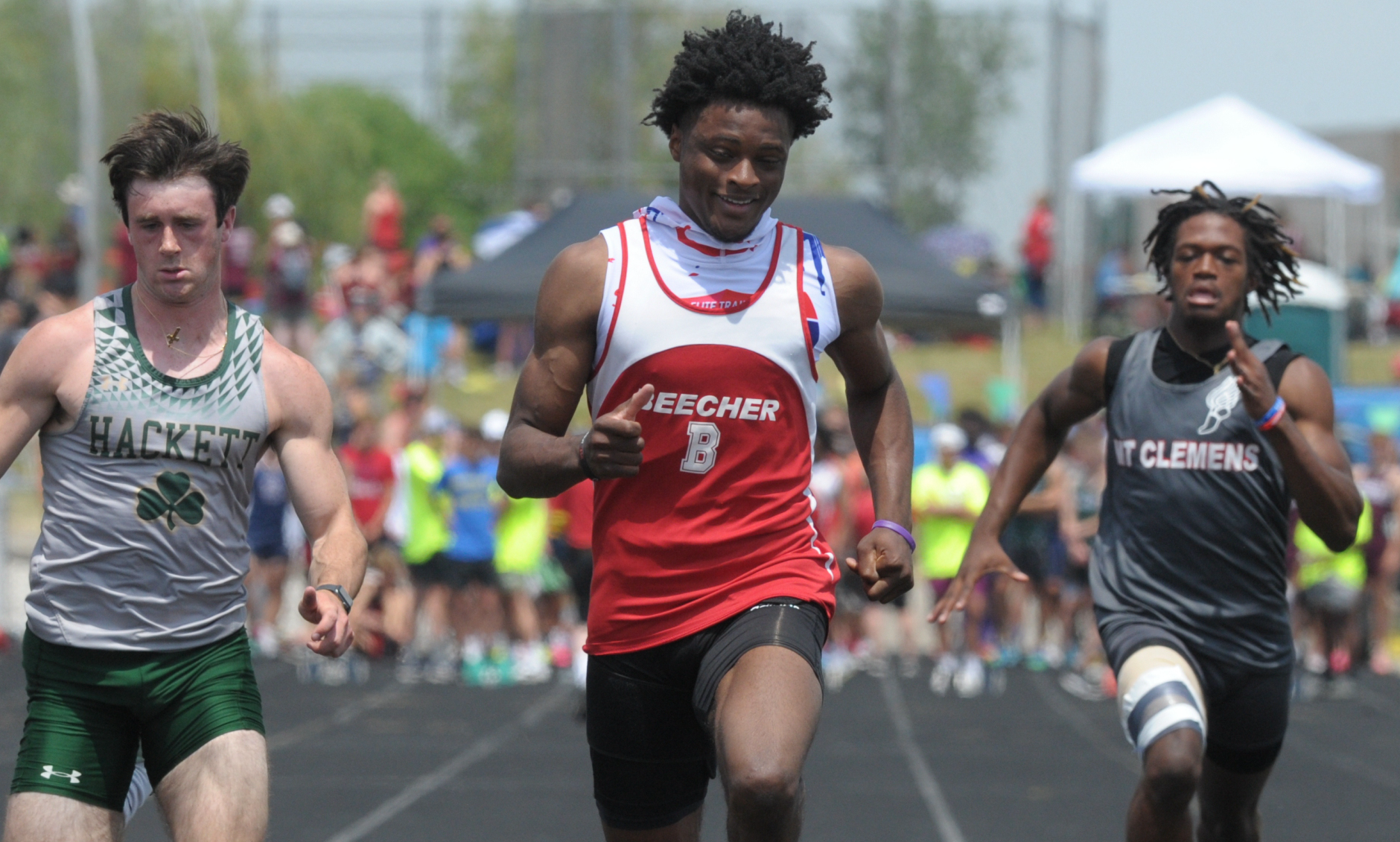
Fantastic 4 Lead Lumen Christi to No. 1
May 30, 2015
By Chip Mundy
Special for Second Half
COMSTOCK PARK – Jackson Lumen Christi came to the Lower Peninsula Division 3 Boys Track and Field Final with just four qualifiers.
The Titans left with a surprising MHSAA championship – the first in school history in track and field.
Lumen Christi’s quartet of athletes totaled 44 points to outdistance runner-up Hillsdale’s 37. Clinton was third with 30 points.
“We weren’t a good dual-meet team, and we didn’t have a lot of depth, but we had some really good individuals,” Lumen Christi coach Mike Woolsey said. “I kind of thought if we put the time in, this sort of thing could happen.
“I’ve seen it with other teams, but never with us. This is great.”
The Titans won only one event. Senior Patrick Ludlow won the 800 in thrilling fashion as he came from behind to nip Ryan Silvestri of Napoleon by less than one second.
“On the first lap, I wanted to be in a good spot in the top two or three,” Ludlow said. “I came around right where I wanted to be. With about 300 to go, I kind of came out first, and then some guys were right with me. Around the 200, I just gutted it out and got the win.”
Ludlow conceded that he did not come to Comstock Park expecting to leave with a team championship.
“Honestly, no. This is so much more than I could have expected,” he said. “It definitely feels better with the team, and it feels good to do both; but to be able to share it with the team is awesome.”
Woolsey said Ludlow followed the script in winning the race.
“He ran the type of race we’ve been practicing all year,” he said. “Watching that race was kind of how I pictured it in my mind.”
Jonathan Scouten, another Lumen Christi senior, had a roller-coaster ride all day. Seeded in the top two in both the shot put and discus, Scouten failed to pick up an individual championship and lost the shot put by a half-inch.
“My day was pretty eventful,” he said. “I was hoping to win both the discus and the shot put, and in the discus I was first going into the finals but ended up getting second. So I was a little disappointed there,” he said. “In the shot put, it was the same thing, except in the finals I ended up losing by a half-inch.
“The whole season has been like this. We’ve been real mellow as a team, and then, what is this? State champions? It’s a blessing. I was about to go home real disappointed, but having this made my day.”
Woolsey said Scouten has gotten to where he is because of hard work and technique and not simply brute strength.
“Over the four years he has improved so much,” Woolsey said. “He’s a hard worker. He’s not the biggest thrower out there, but as far as technique, he’s great. He’s mastered that.”
Lumen Christi junior Wyatt Plate was second in the 200 and third in the 100.
“Plate is just naturally fast, and he has the potential to get even faster,” Woolsey said.
The fourth Lumen Christi athlete to qualify for the meet was junior Jacob Wildenhaus, who took fifth in the 300 hurdles.
Amazingly, there were no multiple individual champions in the meet, and only third-place Clinton managed to bag two titles – one individual and one on a relay.
It was that sort of meet that helped Lumen Christi win a team championship with 44 points.
“You need to have good individuals and have them be on, and it happened,” Woolsey said. “I kind of did the math before and thought we could score a lot of points, but I didn’t know if they would be enough.”
Woolsey has been coaching for 36 years, and he has been involved with winning MHSAA titles for Lumen Christi with boys and girls cross country. But he said winning one in track and field had its own nice touch.
“It’s different,” he said. “Usually with cross country I’m the only coach, so I’m happy for all the other coaches. I’m happy for these kids. It’s fun to be able to take this back to school.”
The other individual champions in the running events were Macomb Lutheran North junior Zach Stadnika in the 110 hurdles, Niles Brandywine senior Andrew Duckett in the 300 hurdles, Sanford-Meridian junior Christian Petre in the 100, Clinton senior Tyler Underwood in the 200, Madison Heights Madison senior Jaylin Golson in the 400, Lansing Catholic senior Keenan Rebera in the 1,600 and Calvin Christian junior Abe Visser in the 3,200.
In the field events, champs were Hesperia junior Nate McKeown (high jump), Reed City junior Nate Fasbender (pole vault), Hillsdale senior Austin Hawkins (long jump), Carson City-Crystal senior Joshua Coston (discus) and Grand Rapids West Catholic junior Carl Myers (shot put).
Hawkins was the defending champion in the long jump.
In the relay events, Clinton won the 40, Marlette the 800, Adrian Madison the 1,600 and Hanover-Horton the 3,200.
PHOTO: Jackson Lumen Christi's Patrick Ludlow finishes his winning 800 run Saturday in helping the Titans to the LP Division 3 team championship. (Click to see more from RunMichigan.com. Photo by Jamie Geysbeek.)

Thrower Claims Lone Individual Title to Lead Hackett to Team 3-Peat
By
Tom Lang
Special for MHSAA.com
June 3, 2023
Kalamazoo Hackett Catholic Prep just keeps winning and winning.
This time the Irish took home their fourth title in the last five Lower Peninsula Division 4 Track & Field Finals, on Saturday at Hudsonville.
Hackett’s only individual title was taken by discus winner Nathan Buchmann, a senior, who was fine knowing he was the shortest in stature among all the sizable competitors.
“In the offseason after football I worked out every day, working towards this goal,” he said after getting his medal. “I would say this takes 80 percent technique and 20 percent strength to throw the discus. So, length can help but if you have good technique and are really strong, that will play into it.
“I think we are very balanced throughout the meet today,” he said about teammates that scored points in finishes other than first place. “We have 13 guys here today, and we have people in a lot of the races. But I do not run; I have too short of legs to be a fast runner,” he said with a chuckle.
Buchmann had to work through a hip injury to compete this spring.
“I think the setbacks are what make you strong,” he said. “You can either give up through the setbacks or push forward and become better.”
 Coach Charissa Dean agreed.
Coach Charissa Dean agreed.
“The kids have big hearts,” she said after all the points were totaled and the Irish were on top once again, with 53. “They worked hard. They had a lot of potential when we started the season. And we had a lot of drive to put in the work, and we are happy the results came out the way they did.”
Reading was runner-up at 47 points, followed by Wyoming Potter’s House Christian with 42, then Fowler and Flint Beecher each with 37 points.
Senior Lezawe “Moses” Osterink, of Potter’s House Christian, placed second in 1,600 but took the 3,200 title as defending champ of both. He dominated the latter by lapping the field with a final lap kick that resembled more of a superhero speedster.
“Nobody really took it out that hard at the start,” he said. “There was a freshman (Marek Butkiewicz of Hackett) that tried to get the pace going quick, but me and Dakota (Dykhuis of Montabella) just kind of sat back and gradually pulled him through.
“We took it gradually, and I was just relying that I could kick.”
Kick did he ever. The trio were neck and neck the majority of the race in a grouping ahead of the pack.
“With 400 to go I just tried to go all out,” Osterink said. “I had a lot more left than I thought and I was pleased with the win. Not really the time, but that doesn’t matter, especially this hot out.”
The overall meet was in the low 90s/high 80s heat and searing sun all day. So, race officials allowed the unique opportunity for coaches to spray the runners with water and give them water bottles.
“It was very weird because I’ve never taken water to drink while I’m running, so I didn’t know how that would feel,” Osterink said. “And they were spraying us and hitting us in the face. It was kind of fun.”
Junior Tyler Lenn of Marine City Cardinal Mooney defeated Osterink at his own game in the 1,600.
“I’m feeling great,” Lenn said after grabbing the medal. “I said to a newspaper after one of my races (during the season) I was right where I wanted to be. This has been a long rebuilding process for me since an injury back in the fall, and I set a pretty high goal the day the injury happened. I was telling myself I needed to fulfill what I said I would do at the beginning of last cross country season. And that is what I did today.”
Lenn suffered an ankle sprain from a misstep that turned worse because he kept running through the season on it.
“Coming back from that was pretty tough, but I wouldn’t have it any other way,” he said.  “Perseverance; I said from the beginning what I was going to do. I kept my eye on that target, and no matter the circumstances life threw at me, that I was going to make it happen and I am a man of my word.”
“Perseverance; I said from the beginning what I was going to do. I kept my eye on that target, and no matter the circumstances life threw at me, that I was going to make it happen and I am a man of my word.”
Jaylin Townsend, a senior from Flint Beecher, dominated the short races. He won the 100 dash (10.67) and 200 dash at 22 seconds flat. It was his third 100 win at a Finals.
“I put in a lot of work; I had to three-peat,” he said after the 100. “There’s a lot of great competition here, so I knew I had to come out and run my best.”
Concord in the 400 (43.72), Buckley in the 800 (1:30.76) and 1,600 (3:29.13) and Potter’s House in the 3,200 (8:14.18) were relay champs Saturday. Reading’s Tayshawn Bester won the 110 hurdles (15.13), and Athens’ Landen Bennett won the 300 (39.85). Caseville’s Nathan Feltner won the 400 (50.76), and Vestaburg’s Owen Patton claimed the 800 (1:55.11).
Fruitport Calvary Christian’s Bradley Richards won the high jump (6-10), and Peck’s Alex Affer won the long jump (23-4). McBain Northern Michigan Christian’s Isaac Bowden was first in pole vault (13-0), and Brown City’s Kyle Affer won shot put (49-2).
PHOTOS (Top) Kalamazoo Hackett Catholic Prep celebrates its third-straight LPD4 title Saturday. (Middle) Cardinal Mooney's Tyler Lenn, far right, sets the pace in the 1,600. (Below) Flint Beecher's Jaylin Townsend, middle, crosses the finish first for one of his two sprint championships. (Photos by Ken Swart/RunMichigan.com.)

